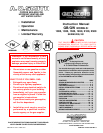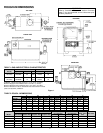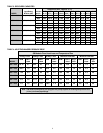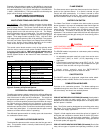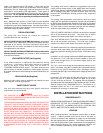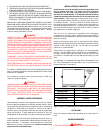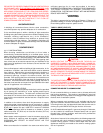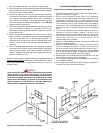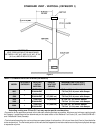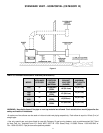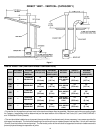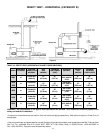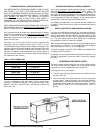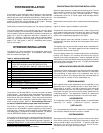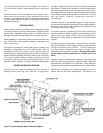
8
PROVIDED FOR PROPER COMBUSTION AND VENTILATION IN
ACCORDANCE WITH
THE NATIONAL FUEL GAS CODE, ANSI
Z223.1 OR CAN/CSA-B149.1 AND .2 (LATEST EDITIONS) OR
APPLICABLE PROVISIONS OF THE LOCAL BUILDING CODES.
AN INSUFFICIENT SUPPLY OF AIR MAY RESULT IN A YELLOW,
LUMINOUS BURNER FLAME, CARBONING OR SOOTING OF THE
FINNED HEAT EXCHANGER, OR CREATE A RISK OF
ASPHYXIATION. DO NOT OBSTRUCT THE FLOW OF
COMBUSTION AND VENTILATION AIR.
UNCONFINED SPACE
In buildings of conventional frame, brick or stone construction,
unconfined spaces may provide adequate air for combustion.
If the unconfined space is within a building of tight construction
(buildings using the following construction: weather stripping, heavy
insulation, caulking, vapor barrier, etc.), air for combustion,
ventilation, must be obtained from outdoors or spaces freely
communicating with the outdoors. The installation instructions for
confined spaces in tightly constructed buildings must be followed
to ensure adequate air supply.
CONFINED SPACE
(a) U. S. INSTALLATIONS
When drawing combustion and dilution air from inside a
conventionally constructed building to a confined space, such a
space shall be provided with two permanent openings, ONE
WITHIN 12 INCHES OF THE ENCLOSURE TOP AND ONE WITHIN
12 INCHES OF THE ENCLOSURE BOTTOM. Each opening shall
have a free area of at least one square inch per 1000 Btuh of the
total input of all appliances in the enclosure, but not less than 100
square inches.
If the confined space is within a building of tight construction, air for
combustion, ventilation, and draft hood dilution must be obtained
from outdoors. When directly communicating with the outdoors or
communicating with the outdoors through vertical ducts, two
permanent openings, located in the above manner, shall be
provided. Each opening shall have a free area of not less than one
square inch per 4000 Btuh of the total input of all appliances in the
enclosure. If horizontal ducts are used, each opening shall have a
free area of not less than one square inch per 2000 Btuh of the total
input of all appliances in the enclosure.
(b) CANADIAN INSTALLATIONS
Ventilation of the space occupied by the boiler(s) shall be provided
by an opening for ventilation air at the highest practical point
communicating with outdoors. The total cross- sectional area shall
be at least 10% of the area of the combustion air opening but in no
case shall the cross-sectional area be less than 10 square inches
(6500 mm
2
).
In addition to the above, there shall be permanent air supply
opening(s) having a cross-sectional area of not less than 1 square
inch per 7,000 BTUH (310 mm
2
/KW) up to and including 1,000,000
BTUH
plus 1 square inch per 14,000 BTU in excess of 1,000,000
BTUH. This opening(s) shall be located at, or ducted to, a point
neither more than 18" (46.0 cm) nor less than 6 inches (15.2 cm)
above the floor level.
Where power vented equipment is used in the same room as the
boiler, sufficient air openings must be supplied. UNDERSIZED
OPENINGS MAY RESULT IN INSUFFICIENT AIR FOR
COMBUSTION.
Where an exhaust fan is installed in the same room with a boiler,
sufficient openings for air must be provided in the walls.
UNDERSIZED OPENINGS WILL CAUSE AIR TO BE DRAWN INTO
THE ROOM THROUGH THE CHIMNEY, CAUSING POOR
COMBUSTION. SOOTING MAY RESULT WITH AN INCREASED
RISK OF ASPHYXIATION.
VENTING
!
This boiler is approved to be vented as a Category I, Category III
(horizontal venting), or a Direct Vent appliance. The Horizontal and
Direct Venting options require a special vent kit.
TABLE 6: DIRECT VENT KITS
Horiz. or Horiz. Direct Vent Kit No. Model Number
211090 G(W,B) 1000
211090-1 G(W,B) 1300
211090-1 G(W,B) 1500
211090-4 G(W,B) 1850
211090-2 G(W,B) 2100
211090-3 G(W,B) 2500
Vertical Direct Vent Kit No. Model Number
211089 G(W,B) 1000
211089-1 G(W,B) 1300
211089-1 G(W,B) 1500
211089-4 G(W,B) 1850
211089-2 G(W,B) 2100
211089-3 G(W,B) 2500
CAUTION
WHEN VENTING THE GENESIS BOILER THROUGH AN
OVERSIZED CHIMNEY (INCLUDING MASONRY CHIMNEYS),
ADDITIONAL CARE MUST BE EXERCISED TO ASSURE PROPER
DRAFT. FOR PROPER OPERATION, A MINIMUM DRAFT OF -0.02"
W.C. AND A MAXIMUM DRAFT OF -0.04" W.C. MUST BE MAINTAINED.
IN INSTANCES OF EXCESSIVE DRAFT, A BAROMETRIC DAMPER
MAY BE REQUIRED TO ASSIST IN MAINTAINING THE PROPER
DRAFT. DRAFT SHOULD BE MEASURED 2 FEET (0.6 M) ABOVE
THE BOILER VENT COLLAR.
WARNING
THE INSTRUCTIONS IN THIS SECTION ON VENTING THE BOILER
MUST BE FOLLOWED TO AVOID CHOKED COMBUSTION OR
RECIRCULATION OF FLUE GASES. SUCH CONDITIONS CAUSE
SOOTING OR RISKS OF FIRE AND ASPHYXIATION.
CONNECTING BOILER TO A COMMON VENT
Do not connect the boiler to a common vent or chimney with solid
fuel burning equipment. This practice is prohibited by most local
building codes as is the practice of venting gas fired equipment to
the duct work of ventilation systems.
Where a separate vent connection is not available and the vent
pipe from the boiler must be connected to a common vent with an
oil burning furnace, the vent pipe should enter the common vent or
chimney at a point ABOVE the flue pipe from the oil furnace.
UL/ULC listed double wall type B-1 gas vents, through 16" diameter,
can be installed in heated and unheated areas and can pass
through floors, ceilings, partitions, walls and roofs, provided the
required clearance is observed.
At the time of removal of an existing boiler, the following steps shall
be followed with each appliance remaining connected to the
common venting system. Perform these steps while the other
appliances remaining connected to the common venting system
are not in operation.



